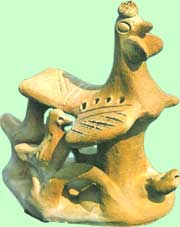 |
: February 2005 |
||||||||
| To E. et A, who always help me to improve this site. To the Portuguese visitors: boa vinda.
Discovery context: This whistle is in a private collection. A tourist bought it in Portugal in the 70s. General description: It is a chicken family. The hen walk before its ckicks and a little rooster stands behind them. Semi-circles round the socle. The chicks are placed between these arcs. The whistle is in a good state. It is 5.4 inch long, 4.37 high and 2.95 large. The decoration: The whistle is made in a white clay painted with a synthetic paint. The basic colors are red, pink, yellow and green. Under the socle is a stamp: ROSA CÔTA |

Backstamp ROSA CÔTA |
||||||||
| Study of the object:
Typology: This whistle is a perfect illustration of Mrs Nixdorff's category B4 "figurines with the whistle on the socle". The whistle is in front of the figurine. As it is a short whistle of a small diameter, the whistle is a high tone. Analysis:
The maker signed this whistle and one can see this model in many papers about the clay whistles. No mystery for its attribution. Furthermore, the rooster is so typical of the Portuguese pottery that looking at this whistle is thinking to the village of Barcelos where those figurines are still made today.
Choosing this whistle for February was an opportunity to study the Portuguese whistles. A more complete study can be read in the pages about Portugal (in French). |
 Nixdorff's classification |
||||||||
 Hen and chicks before painting Rosa Côta 1977 |
 Barcelos BarcelosBarcelos is a village in the Minho region in the North of Portugal. Famous for its clays figures, it has been known since the 1930s for its clay rooster, a souvenir from Portugal that tourists took away to all countries. A female production: Several families of traditional potters have been quoted since the 20th century to nowadays. Usually, the figurines were made by the women while their husbands turned the bigger pieces and walked around the feast and fears of Portugal to sell the production. Nowadays, this production still exists but the figurines are bigger. Ususally, they are no more whistles and, since the 1960s, the clients have changed: the tourists and collectors replaced children. After that this knowledge has been passed down from mother to daughter for many generations, the grand-sons and great-grand-sons took up the torch. Angelica Lima CRUZ, studying this production, considers a very pertinent question: "Did figurative clay work have no prestige because it was made by women, or was it made by women because it had no prestige?" | ||||||||
Rosa Côta. Rosa Côta (Rosa Da Rocha) was born in Santa Maria de Galegos (commune de Barcelos) circa 1904, her father João Domingos da Rocha (Domingos Côto) was a potter. She has modeled clay figurines since she was 15. Her brother, João Côto also made figurines. Her father created in the 1930 the famous Barcelos rooster (Galo de Barcelos, the national symbol of Portugal). She was married to Edouardo Fernandes de Souza, wellknown for his "nightingales" (water whistles). Her sister-in-law, Maria Sineta, was also a clay figurines maker of Barcelos. The typical whistles of Rosa Côta were the roosters, the hens and chickens but also the bulls ans the musicians. It is hard to date the whistles of the potters of Barcelos during the 20th century because, as for Rosa Côta, the other women who still made them in the 1970s begun to make them after 1914. Thus, the Portuguese whistles of the Folk Museum in Berlin made in 1936 are similar to whistles bought in the 1970s ou 80s. But, the whistle of the month has a stamp what is typical of the late production of thses potters "I would not sign my work, I would be ashamed. They were the ones (the buyers) that asked me" Ana Baraça 1995 Rosa Côta died ca 1990 but her daughter Júlia Côta has made whistles and figures with her for years. Her other daughter Emilia Côta still makes the famous Barcelos roosters. |
 Rosa Côta 1977 Numéro spécial L'argile; Jeunes années magazine 06/1977 |
||||||||
 Mould of a man an musician after adding the accessories 1977 |
The traditional technics :
The whistles of Barcelos were made using three traditional technics. The moulding: This technic is used for the human figures especialy for the musicians. The body is moulded by stamping. After that, the arms and accessories are added and sealed with clay barbotine to the body.
The modeling By using this technic, the women of Barcelos shew their creativity. Their figures are now considered as real artistic works.
The turning As we said, the potter's wheel was reserved for men and such whistles (nightingales and cuckoos) turned on the wheel was the husbands'work. It explains that Rosa Côta's husband made nightingales.
| ||||||||
Rosa Côta was, with Misterio and Ana Balada, a witness of the evolution of the production of the clay figures during the 20th century. Until the fall of 1929, such production was made to produce the toys sold by the potters in the fears and pilgrimages when they sold their dishes. But in the same time and also due to turism, the clay figures begun to be recognized. The potters stopped to be anonymous and even more, some of them became famous. Rosa Côta was one of the last potters to preserve the traditional production of whistles. |
 How to make the whistle inserted into the socle 1977 |
||||||||